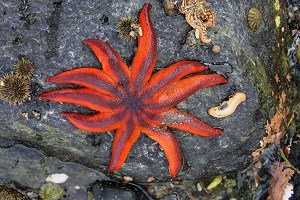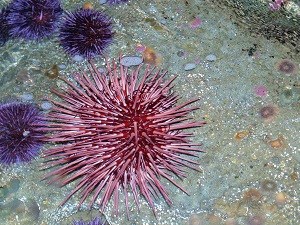
StarfishStarfish are among the principal predators of the intertidal zone. Although several species are found locally, almost all that are seen in the Bartlett Cove area are the five armed mottled starfish, Evasterias. Starfish are echinoderms, related to sea urchins and sea cucumbers. When exposed at low tide a starfish will be inactive, but if it is picked up and turned over, it is frequently possible to see what it has been eating. A starfish feeds on such animals as mussels and snails by everting its stomach, or turning it inside out, through its mouth and into the shell of the prey. Digestion takes place outside the starfish’s body. In many places starfish play a very important role in the ecology of the shore. By feeding mostly on mussels, one species of starfish clears enough space (which would otherwise be choked by mussel beds) to allow a variety of other species to live in the area. On the top side of the starfish, the side away from the mouth, are many tiny pinching organs. These perform several important functions, including fending off other starfish. The pinchers can usually be felt by placing the back of the hand on the starfish’s upper surface. Hold the hand in that position for several seconds, then withdraw it slowly. The pinchers can be felt tugging on the hairs of the hand. On the bottom of the starfish, in the grooves, are hundreds of appendages called “tube feet.” Each has a suction cup at the end. The tube feet are used for locomotion and for holding onto prey and rocks. 
Sea UrchinsSea urchins (Strongylocentrotus) are sometimes exposed at very low tides in Bartlett Cove. During such tides large numbers of urchins can be seen in the lagoon channel just below the low tide line where they dominate large areas. Sea urchins, relatives of the starfish, are plant eaters and account for the absence of algae from the channel or adjacent areas. Sea urchins play a very important role in the marine environment by determining the amount and type of plants that are present in many areas. Some larger algae can be seen in the quiet waters of the lagoon near the channel. These algae probably survive because sea urchins don’t like the still muddy water outside of the fast-flowing channel. The sea urchin uses its spines for protection, locomotion, and to transport plant material to its mouth which is located on the underside of its body. Like a starfish, the sea urchin has pinching organs between its spines, and tube feet which it uses to move and attach itself to the substrate. The internal skeleton of a sea urchin is called a test. Many tests can be found in the lower intertidal, and close examination will show what fascinating structures they are. The large hole in the bottom side is where the mouth once was. The many small knobs covering the test are where the spines were attached, and the hundreds of very small holes are where the tube feet passed through the test. |
Last updated: March 16, 2018
